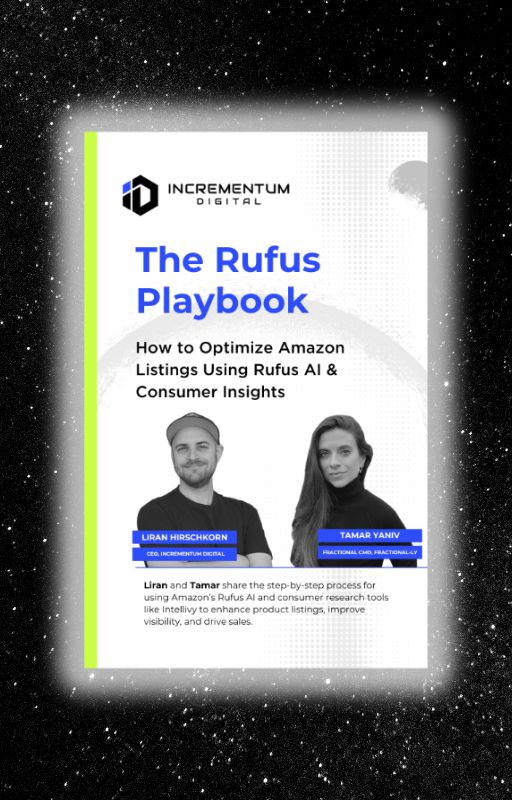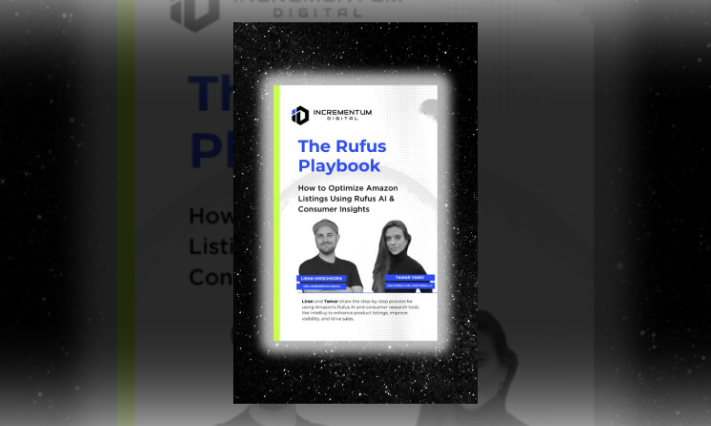Performance Growth
Challenger Brands Redefining Personal Hygiene: Enter DUDE Wipes and Tushe

In a category long defined by utility and shelf space, hygiene products are undergoing a transformation. Consumers no longer shop the aisle passively; expectations have shifted from commodity basics to personalized, brand-driven experiences. What once was a race to the bottom on price or materials is now a contest of relevance, identity, and emotional connection.

Learn How to Make Listings That Convert in 2025!
Read our step-by-step guide on how to optimize your listings using Rufus AI insights. Sign up for our newsletter and get your copy for free!
Show me howThat’s where challenger brands come in. But what is a challenger brand? It’s a company that enters an established category not to imitate, but to rethink it. Challenger brands don’t compete by being marginally better—they compete by being meaningfully different. They focus on real consumer friction points, lead with authentic stories, and build emotional resonance in spaces once ruled by functional parity.
As Liran Hirschkorn highlights in his posts on disruptor brands and how Dude Wipes gets it right, challenger brands are scaling in even the most saturated categories by combining product innovation with bold, founder-led narratives. Tushé and Dude Wipes are prime examples. One reinvents flushable hygiene with a foam that solves environmental and usability gaps. The other builds a bold, culturally tuned identity that cuts through noise with humor and conviction. Both prove the same point: in hygiene, it’s not just what the product does, but also how it makes you feel seen.
Dude Wipes – The Power of Brand-First Marketing
Dude Wipes was conceived in a college apartment when Sean Riley and his roommates realized there were no flushable wipes tailored for men. This insight led them to create a product that filled a gap in the market, eventually growing into a company with over $200 million in annual sales.
The brand’s identity is built on irreverent humor and a casual, relatable tone. Embracing bathroom humor and a laid-back style, Dude Wipes positions itself as a friend in the room, making conversations about hygiene less awkward and more approachable.
Dude Wipes’ marketing strategy includes bold tactics like sponsoring UFC fighters, NASCAR races, and even creating a giant inflatable butt at trade shows to draw attention. Their use of humor and eye-catching stunts has not only entertained but also effectively promoted their products.
After experimenting with product line extensions, such as deodorants and soaps, the team realized the importance of focusing on their core product. This strategic decision allowed them to allocate resources effectively and maintain their position as a leader in the flushable wipes market.
Dude Wipes’ success underscores the impact of a strong, authentic brand voice combined with strategic focus. By understanding their target audience and delivering a product that resonates, they’ve transformed a simple idea into a thriving business.
Tushe – Solving for the Gaps Flushable Wipes Created
Tushé entered the personal hygiene market with a clear mission: eliminate the environmental and plumbing issues caused by so-called “flushable” wipes. Despite their convenience, these wipes are a major source of microplastic pollution and clogged pipes, an issue often downplayed by larger brands.
Tushé’s response is a biodegradable cleansing foam that transforms standard toilet paper into an effective, eco-conscious alternative to wet wipes. The product is packaged in an aluminum bottle and dispensed as a light, moisturizing foam that’s gentle on the skin and safe for plumbing. Their Kickstarter campaign not only validated the demand (quickly exceeding its funding goal) but also highlighted a key market gap: consumers want sustainable hygiene without compromising on cleanliness or convenience.
This approach carves out a new subcategory: wipe alternatives. Instead of competing head-to-head with legacy brands, Tushé reframed the category by solving a real user problem: environmental guilt and household maintenance costs caused by wipes.
For Amazon-focused CPG brands, Tushé’s strategy is instructive. Solving an unsexy but persistent problem is a fast track to differentiation. In crowded marketplaces, visibility is won not by outspending competitors, but by standing out with products that answer overlooked needs.
Format + Story = Shelf and Scroll Power
In the competitive hygiene aisle, where most products look and sound the same, brands like Tushé and Dude Wipes stand out by blending physical innovation with a strong founder narrative. This combination isn’t just clever marketing. It directly impacts both physical shelf appeal and digital engagement.
Tushé disrupted the flushable wipe category by rethinking what “flushable” really means. Instead of repackaging the same product, they created a new delivery system: foam that turns regular toilet paper into a wet wipe. Their Kickstarter campaign leaned heavily into storytelling, presenting Tushé as a solution born out of sustainability and practicality. The clean, minimal design matched the brand ethos, and the message resonated, whoffering a better bathroom experience without harming plumbing or the planet.
Dude Wipes, meanwhile, tackled a different cultural blind spot: the lack of hygiene products made specifically for men. The brand fused bold packaging, irreverent humor, and a clear founder-driven backstory to build a brand that feels more like a movement. Appearances on Shark Tank, strategic retail placement, and influencer partnerships (not to mention a giant plastic butt at trade shows) helped them drive attention. But it’s the consistency in tone and identity that has earned them loyalty and scale.
The implications for Amazon brands are clear. First, CTRs jump when formats break expectations. These new forms signal difference at a glance. Second, effective A+ content doesn’t just repeat ingredients. It shows function. Demonstrating how the product is used (on skin, in hand, in context) builds trust faster than any bullet point list.
Finally, demand generation beats pure PPC. When brand identity and product story are compelling, they drive off-Amazon buzz that fuels branded search. That means lower CAC, stronger conversion, and more defensible market share. For challenger brands, format and story aren’t add-ons. They are the growth engine.
What This Means for CPG Innovators
Breakthroughs in consumer goods rarely come from ingredients alone. They come from eliminating friction and making people care.
Before developing or launching your next product, challenge it with a sharper lens. These four checkpoints separate incremental updates from breakout innovations:
- Are you solving a tangible, recurring friction point in the consumer journey?
Look beyond abstract benefits. What is the everyday annoyance your product eliminates: portability, mess, dosing, confusion, waste? If you’re not replacing frustration with ease, you’re just adding noise. - Does your format or function deliver differentiated utility?
Ask what makes your delivery method meaningfully better. Does it save time, reduce steps, simplify routines, or unlock new usage occasions? Value now extends beyond ingredients to include the entire usage experience. - Is there a founder story or origin insight that sparks curiosity and builds trust?
Why you and why now? Authentic stories rooted in personal experience, unmet needs, or cultural insight can become core to positioning and media strategy. Retail buyers and consumers alike respond to narrative clarity. - Can you visualize the product in action, instantly and intuitively?
If your packaging, A+ content, or ad creative can’t demonstrate how it works in three seconds or less, you’ll lose in both scroll and shelf environments. Design for comprehension, not just aesthetics.
Your customers need a reason to believe your product deserves shelf space. Leading with a story humanizes the pitch and clarifies the “why” behind your brand. It’s the same on Amazon: brands that differentiate visually and narratively drive higher CTR, stronger A+ content engagement, and more branded search volume.
There’s also immense white space in “boring” categories. From toilet paper to supplements, the most overlooked products often carry the biggest upside: if you reframe the problem and find a new angle. As we’ve seen with brands like Tushé and Dude Wipes, even legacy categories can be flipped with a better format and a compelling story.
Innovation doesn’t always mean reinventing the product. Sometimes, it’s just about making people care again.
Let’s Give Them a Reason to Care
Better formulations alone don’t move markets; brands do. Format and narrative work together to command attention, build loyalty, and convert more effectively than specs alone. In categories overflowing with sameness, products that show their value and say something memorable always win.
If you’re a supplement or wellness brand ready to rethink how you show up on Amazon and beyond, our team at Incrementum is here to help. We’ve scaled founder-led brands through Amazon DSP, full-funnel campaigns, and creative built to differentiate.
Request a strategy audit and let’s map the growth levers that matter.
LET’S DISCOVER WHAT’S POSSIBLE FOR YOUR BRAND
We’re here to listen and uncover opportunities tailored to your unique goals.
Fill out the form to get started, and you’ll walk away with real insights and actionable recommendations—whether we work together or not.
- HANDS-ON LEADERSHIP
- AWARD-WINNING PARTNERSHIPS
- CUSTOM-BUILT SOLUTIONS




